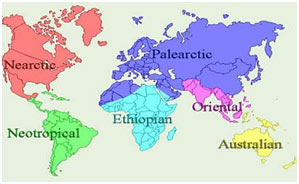The Oriental Region
In this article, we will discuss climatic conditions, physical features, and faunal composition of the Oriental region.
Extent
The Oriental region is mainly formed of Asia and its tropical parts including Pakistan (not Baluchistan), India, Sri Lanka, Burma, etc. This region is divided into further subregions as follows:
Indian subregion:
It consists of North India, the Central part, Himalayas, and Malabar Coast. This region has deserts and plains. It has tropical and temperate conditions. It has antelopes, many species of snakes, and peacocks.
Chelonian subregion:
This consists of Ceylon, Small India Peninsula and contains Loris, Elephants, Snakes, Rats and other important animals.
Indo-Malayan subregion:
Malayan Peninsula and surrounding islands are part of it. There are around 132 families of fauna including mammals like rhinoceros, etc. Badgers, broadbills are common here.
Indo-China subregion:
This subregion includes the south of the Palaearctic region and China. It shows diversity in animals and has amphibians like frogs, salamanders, big mammals like elephants and rhinoceros.
Physical features and Climatic conditions:
The Oriental region is separated from the Palaearctic region by the Himalayas in the North and is surrounded by the Indian Ocean and the Pacific Ocean on other sides. At the southeast corner, there are no physical boundaries; where the Malayan archipelago extended until they reach Australia.
There is a great diversity of physical features in this region. Northern India is mainly grassy plains with scattered trees and bushes. The northwest of the Oriental region is all deserts. However, the southern part of the Oriental region is occupied by prolific and abundant forests.
The regions like Sri Lanka, Malaysia, Indonesia, and Indochinese parts are almost fully occupied by tropical forests with greater diversity and are rich in fauna.
The Oriental region has a mainly tropical climate. Southern parts have almost constant temperature and are seldom higher than 30 ᵒC. In the northern parts of the Oriental region, the temperature lies between 10 ᵒC to 20 ᵒC during autumn and winter. The temperature rises in spring and summer.
Zoological Characteristics:
There are 153 families of terrestrial vertebrates in the Oriental region. Out of which 10 are peculiar and unique to this region. These are as follows:

Mammals
The Oriental region has 30 families of mammals out of which 5 are indigenous to this region. These are Hylobatidae (Gibbons), Tarsidae (Tarsiers), Tupaiidae (Tree shrew), and Galeopithecidae; a Philippine flying lemur also called Colugo. It has a furred membrane between its forelimbs and hindlimbs.
This region shares twenty-five percent of fauna with the African region which includes monkeys, lorises, pangolins, elephants, rhinoceros, bamboo rats, etc. zoological characteristics shared with the Palaearctic region include lynx, hyenas, pigs, civets, hedgehogs, bears, etc.
The fauna shared with the Neotropical region is Tapir. There are also deer, moles, bears are present.
Aves:
There are 66 families of birds in this region. Out of which 53 are widespread and eurytopic. Only one family of birds is endemic to this region. This region has mainly brilliantly colored birds such as bulbuls, bluebirds, bee-eater, pigeons, kingfishers, orioles, thrushes, etc.
The birds shared with the African region are parrots, cuckoos, hornbills, and sunbirds. The birds shared with the Palaearctic region are pheasants. There are 4 genera and 14 species of leafbird residing in this region.
Reptiles:
Reptiles are very well represented in this region. It includes a particularly large number of poisonous snakes, Vipers, Common Kraits, Pythons, and Cobras. There are many lizards in this region that are widely represented by geckos and skinks. In addition to crocodiles, there are gavials native to India and Malaya.
Freshwater turtles, big head turtles are restricted to this region.
Amphibians:
There are fewer distinctive amphibians in this region. There are frogs and toads widely distributed. Indochina has few numbers of tailed amphibians. Flying frog is found in Western Indian Ghats.
Fish:
There are dominant species of carps and catfish. Mullets, mud-eels, and loaches are confines to this region. One species of paddlefish is found in the Yangtze River in China.
Affinities to other regions
Oriental fauna shows great resemblance to the Ethiopian region due to somehow similar environmental conditions. This is neither rich in endemic fauna nor a wide range distribution. In spite, of their resemblance, there are striking differences between these two regions.
Unlike Ethiopia, this region has moles, bears, tapir, and deer. In contrast, it does not contain coneys, wild horses, and jerboas.

